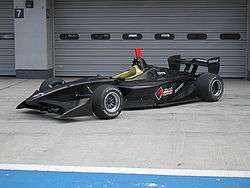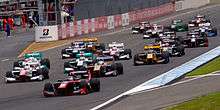Super Formula Championship
Super Formula, formerly known as Formula Nippon, is a type of formula racing and the top level of single-seater racing in Japan.
 | |
| Category | Single seaters |
|---|---|
| Country | Japan |
| Inaugural season | 1973 |
| Drivers | 20 |
| Teams | 11 |
| Constructors | Dallara |
| Engine suppliers | |
| Tire suppliers | Yokohama |
| Drivers' champion | |
| Teams' champion | DoCoMo Team Dandelion Racing |
| Official website | superformula.net |
Formula Nippon evolved from the Japanese Formula 2000 series begun in 1973 by way of the Japanese Formula Two and Japanese Formula 3000 championships. For the most part, the Japanese racing series have closely followed their European counterparts in terms of technical regulations, but there have been some important exceptions.
History
Formula 2000 (1973–1977)
Background
In Japan, though touring and sports car racing was very popular through the 1960s, formula car racing was less so in those days. Even the Japanese Grand Prix lost its popularity after changing its format from touring/sports car racing to formula car racing in 1971.
In 1973, the Japan Automobile Federation (JAF) established the "All-Japan Formula 2000 Championship" as the first top-level formula racing series in Japan, to promote popularity of formula car racing in the country.
The series was created based on the European Formula Two Championship. But the JAF approved use of purpose built racing engines was different from the European F2 series which only allowed race engines based on mass production models. Due to this difference, the series did not fit in with the Formula Two regulations in those days. Therefore, the series was renamed "Formula 2000", not "Formula Two".
Formula Two (1978–1986)
_front-right_Honda_Collection_Hall.jpg)
The revised Formula Two regulation in 1976 removed the restriction about engines which had limited the use of engines based on mass production models. With this change the reasoning behind the name "Formula 2000" disappeared. It led to the series being renamed the "All-Japan Formula Two Championship" from 1978.
1987 championship
When European Formula Two ended in 1984, its Japanese counterpart did not follow suit immediately. The JAF considered starting a new Formula Two series from 1988. However, all entrants ran Formula 3000 cars in 1987. So, the 1987 Formula Two Championship was cancelled due to no entry of any cars for that format.
Formula 3000 (1987–1995)
Switching to the open Formula 3000 standard in 1987, the "All-Japan Formula 3000 Championship" started in 1988. Once again, Japanese and European regulations paralleled one another until 1996, when the International Formula 3000 series became a one-make format to lower costs.
In the late 1980s, Honda-powered Formula One teams began winning multiple championships, and the Japanese Grand Prix was reintroduced in 1987, resulting in an increased interest in formula racing. Combined with by the bubble economy, the Japanese Formula 3000 attracted several entrants and investors. It attracted many promising young drivers outside of Japan to compete in the series. Inevitably, the bubble burst led to the decline of the series.
Formula Nippon (1996–2012)

In the mid-1990s, the Japanese Formula broke away, changing the form of the series to "Formula Nippon". The new Japan Race Promotion, formed by Fuji Television, became the promoter with the recognition of the series by the JAF as the Authority Sport Nationale (ASN) of Japan.
In the 2000s, sports car racing became more popular in Japan, and many Formula Nippon drivers doubled-up in the Japanese Super GT championship.
The 2006 season got off to one of the strangest starts in motorsport history. Because of heavy rain, the opener at Fuji was called off after two safety car laps, and Benoît Tréluyer was awarded the win with half points awarded.
Cars

Until 2002, Formula Nippon was an open formula, where a variety of chassis builders and engine manufacturers could compete. Chassis were supplied by Lola, Reynard, and G-Force, while Mugen-Honda supplied the vast majority of the engines (though Cosworth engines were found in the Formula 3000 era).
However, with the bankruptcy of Reynard in 2002, and the withdrawal of G-Force a year earlier, Formula Nippon once again followed F3000's lead in becoming a one-make series for the 2003 season. Formula Nippon cars were now all Lola B03/50 chassis powered by Mugen-Honda engines; however, unlike F3000, engines in Formula Nippon are open-tuned by private companies.
In 2006 Formula Nippon underwent a drastic revision of its regulations. A new Lola FN06 chassis was introduced, while the engine formula underwent drastic revision. Engine blocks were provided by Toyota and Honda, using the same engine block specifications as found in the 2005 Indy Racing League, with open-tuning still permitted.
American racecar manufacturer Swift Engineering produced the FN09 chassis that was used from 2009 through 2013.
Scoring System
- Points are awarded in line with the standard FIA system used from 2003 to 2009, but with a bonus point given for pole position.
| Position | 1st | 2nd | 3rd | 4th | 5th | 6th | 7th | 8th | Pole |
|---|---|---|---|---|---|---|---|---|---|
| Points | 10 | 8 | 6 | 5 | 4 | 3 | 2 | 1 | 1 |
Cars
The base chassis for the series is the Dallara SF19, which was unveiled at Suzuka Circuit on October 2017. The SF19 was regulated to weigh 670 kilograms (including driver), and is powered by two-litre single turbo-charged engines from Honda and Toyota. While sharing the same base architecture as the NRE engines used in Super GT GT500 cars, the engines are detuned relative to their GT counterparts. It features a 'push to pass' style overtake system which allows for additional 5kg/h of fuel flow to be used when active - increasing power.
The previous generation of the car, the Dallara SF14, was used between the 2014 to 2018 season, which featured at least 30% components manufactured in Japan.[1]
Comparable to a contemporary Formula One, the pole position lap in a Super-Formula Dallara SF14 at Suzuka Circuit in 2017, 1:35.907, is 8.588 seconds or 9.0% slower than the pole position time for the 2017 Japanese Formula One Grand Prix.
Specifications (2014-2018)
- Engine displacement: 2.0 L (122 cu in) DOHC inline-4
- Gearbox: 6-speed paddle shift gearbox
- Weight: 660 kg (1,455 lb)
- Power output: 543 hp (405 kW)
- Fuel: 102 RON unleaded gasoline
- Fuel delivery: Direct fuel injection
- Aspiration: Single-turbocharged
- Length: 5,268 mm (207 in)
- Width: 1,900 mm (75 in)
- Wheelbase: 3,165 mm (125 in)
- Steering: Electric power-assisted rack and pinion
Specifications (2019-present)
- Engine displacement: 2.0 L (122 cu in) DOHC inline-4
- Gearbox: 6-speed paddle shift gearbox
- Weight: 670 kg (1,477 lb)
- Power output: 543 hp (405 kW)
- Fuel: 102 RON unleaded gasoline
- Fuel delivery: Direct fuel injection
- Aspiration: Single-turbocharged
- Length: 5,233 mm (206 in)
- Width: 1,910 mm (75 in)
- Wheelbase: 3,115 mm (123 in)
- Steering: Electric power-assisted rack and pinion
Drivers
However, despite the more technically demanding regulations, the Japanese top-level formula series remains a national series, with second tier status compared to the FIA Formula 2 and its predecessor GP2. Foreign drivers have always been regular participants in the Japanese championships, and there have been several drivers to come from a Japanese Formula 3000 or Formula Nippon drive to a prominent Formula One role; the best-known of these are Eddie Irvine, Ralf Schumacher, the 1996 Formula Nippon champion, and Pedro de la Rosa, the 1997 Formula Nippon champion.
Champions
* The ( ) indicates there were no other supplier or a model in the year.
References
- Collins, Sam (26 March 2013). "2014 Super Formula concept revealed". racecar-engineering.com. Retrieved 22 September 2016.
External links
| Wikimedia Commons has media related to Super Formula. |
- Japanese Championship Super Formula official website (in English)
